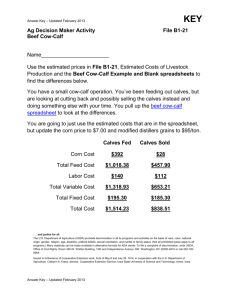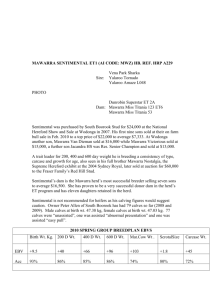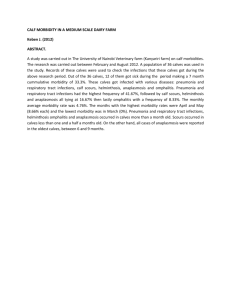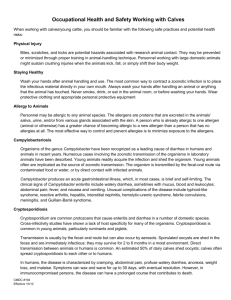a comparison of the antibiotic enrofloxacin and cholestyramine
advertisement
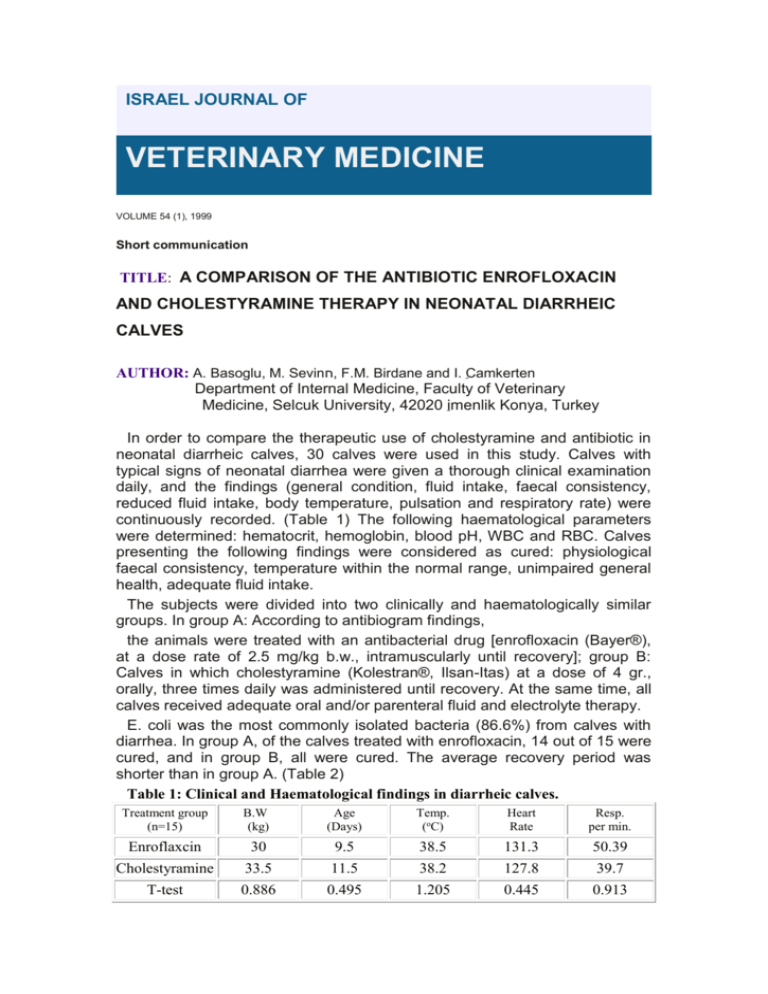
ISRAEL JOURNAL OF VETERINARY MEDICINE VOLUME 54 (1), 1999 Short communication TITLE: A COMPARISON OF THE ANTIBIOTIC ENROFLOXACIN AND CHOLESTYRAMINE THERAPY IN NEONATAL DIARRHEIC CALVES AUTHOR: A. Basoglu, M. Sevinח, F.M. Birdane and I. ַCamkerten Department of Internal Medicine, Faculty of Veterinary Medicine, Selcuk University, 42020 ַimenlik Konya, Turkey In order to compare the therapeutic use of cholestyramine and antibiotic in neonatal diarrheic calves, 30 calves were used in this study. Calves with typical signs of neonatal diarrhea were given a thorough clinical examination daily, and the findings (general condition, fluid intake, faecal consistency, reduced fluid intake, body temperature, pulsation and respiratory rate) were continuously recorded. (Table 1) The following haematological parameters were determined: hematocrit, hemoglobin, blood pH, WBC and RBC. Calves presenting the following findings were considered as cured: physiological faecal consistency, temperature within the normal range, unimpaired general health, adequate fluid intake. The subjects were divided into two clinically and haematologically similar groups. In group A: According to antibiogram findings, the animals were treated with an antibacterial drug [enrofloxacin (Bayer®), at a dose rate of 2.5 mg/kg b.w., intramuscularly until recovery]; group B: Calves in which cholestyramine (Kolestran®, Ilsan-Itas) at a dose of 4 gr., orally, three times daily was administered until recovery. At the same time, all calves received adequate oral and/or parenteral fluid and electrolyte therapy. E. coli was the most commonly isolated bacteria (86.6%) from calves with diarrhea. In group A, of the calves treated with enrofloxacin, 14 out of 15 were cured, and in group B, all were cured. The average recovery period was shorter than in group A. (Table 2) Table 1: Clinical and Haematological findings in diarrheic calves. Treatment group (n=15) B.W (kg) Age (Days) Temp. (oC) Heart Rate Resp. per min. Enroflaxcin 30 9.5 38.5 131.3 50.39 Cholestyramine 33.5 11.5 38.2 127.8 39.7 T-test 0.886 0.495 1.205 0.445 0.913 Treatment group (n=15) Dehyd. % Faecal color+cons HT (%) Hb (gr.) RBC (x/l) WBC (x/l) pH Enroflaxcin 8.1 Yellowish watery 50.3 8.03 7114 9640 7.021 Cholestyramine 8.4 Yellowish watery 49.3 7.9 6587 8160 7.005 T-test 0.293 Yellowish watery 0.814 0.249 0.816 0.721 0.215 Table 2: Course of recovery in diarrheic calves. Days to recovery Enrofloxacin Cholestyramin 1 2 3 4 5 6 7 Died # affected 1 - 8 - 1 2 2 1 % affected 6.6 - 53.3 - # affected 10 3 2 - - - - - % affected 66.6 20 20 - - - - - 6.6 13.3 13.3 6.6 Clinical trials on antibiotic use in calves with undifferentiated diarrhea have produced inconsistent results. In one study survival rates were slightly higher in calves that received oral and parenteral antibiotic therapy than those that were untreated. However, in another study, a larger number of calves given prophylactic antibiotic therapy developed diarrhea than those that received no treatment (1). According to Rademacher and Dirksen (2) antibacterial therapy is only indicated in approximately 25% of the calves with neonatal diarrhea and enrofloxacin seems to be more effective than other antibiotics and chemotherapeutic drugs. In the present study also, enrofloxacin was used in one group of calves, but the days of recovery were not shorter than in the other group and one animal died. Cholestyramine is a non-absorbable anion exchange resin that is used predominantly for the treatment of hypercholesterolemia in adults and the management of acute diarrhea in children (3). Cholestyramine treatment of newborn infectious diarrhea has been shown to be effective (4). Therapy with cholestyramine dramatically reduced bowel movements and led to significant reversal of weight loss (5). It is thought that compounds such as cholestyramine are more efficacious and are safer than antibiotics and anticholinergics (6). In accordance with these findings, in the present study in calves treatment with cholestyramine, the days of recovery were much shorter than in calves treated with antibiotic. In conclusion, cholestyramine may be used in preference to antibacterial therapy in the treatment of neonatal diarrhea. References 1. Shull, J.J. and Fredrick, H.M.: Adverse effect of oral antibacterial prophylaxis and therapy on incidence of neonatal calf diarrhea. WM/SAC 73, 7: 924-930, 1978. 2. Rademacher, G. and Dirksen, G.: Comment on the relevance of antibacterial therapy in calf diarrhea. Bayer Catalogue, 101-104, 1994. 3. Scheel, P.J., Whelton, A., Rossiter, K. and Watson, A.: Cholestyramineinduced hyperchloremic metabolic acidosis. J. Clin. Pharmacol. 32: 536538, 1992. 4. Rateau, J.G., Brouillard, M., Morgant, G. and Aymard, P.: Etude experimentale chez le lapin de I’ effect de la cholestyramine dans le traitement des diarrhיes infectieuses d’origine cholerique. Ann. Gastroenterol. Hepatol. 26: 27-30, 1986. 5. Steuerwald, M., Bucher, H.C., Muller-Brand, J., Gotze, M., Roser, H.W. and Gyr, K.: HIV-enteropathy and bile acid malabsorption response to cholestyramine. Am. J. Gastroenterol. 90(11): 2051-2053, 1995. 6. Wilcke, J.R. and Turner, J.C.: The use of adsorbent to treat gastrointestinal problems in small animals. Seminars in Veterinary Medicine and Surgery. Small Animal 11(4): 266-273, 1987.
